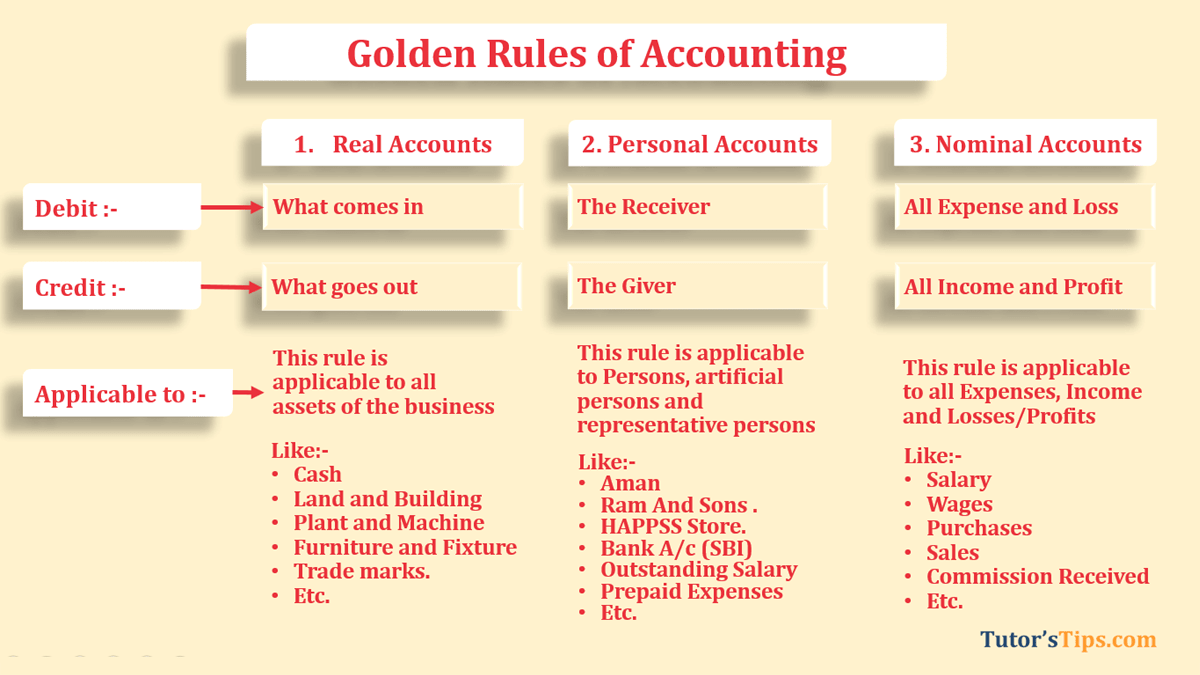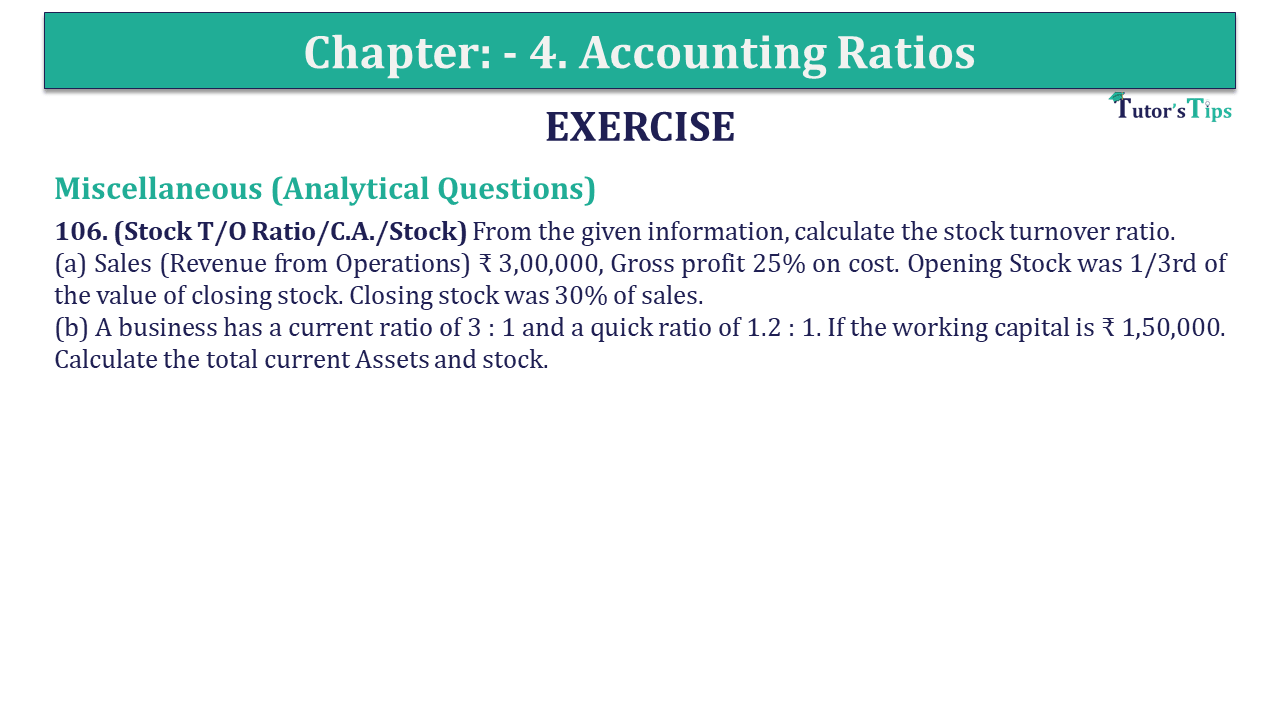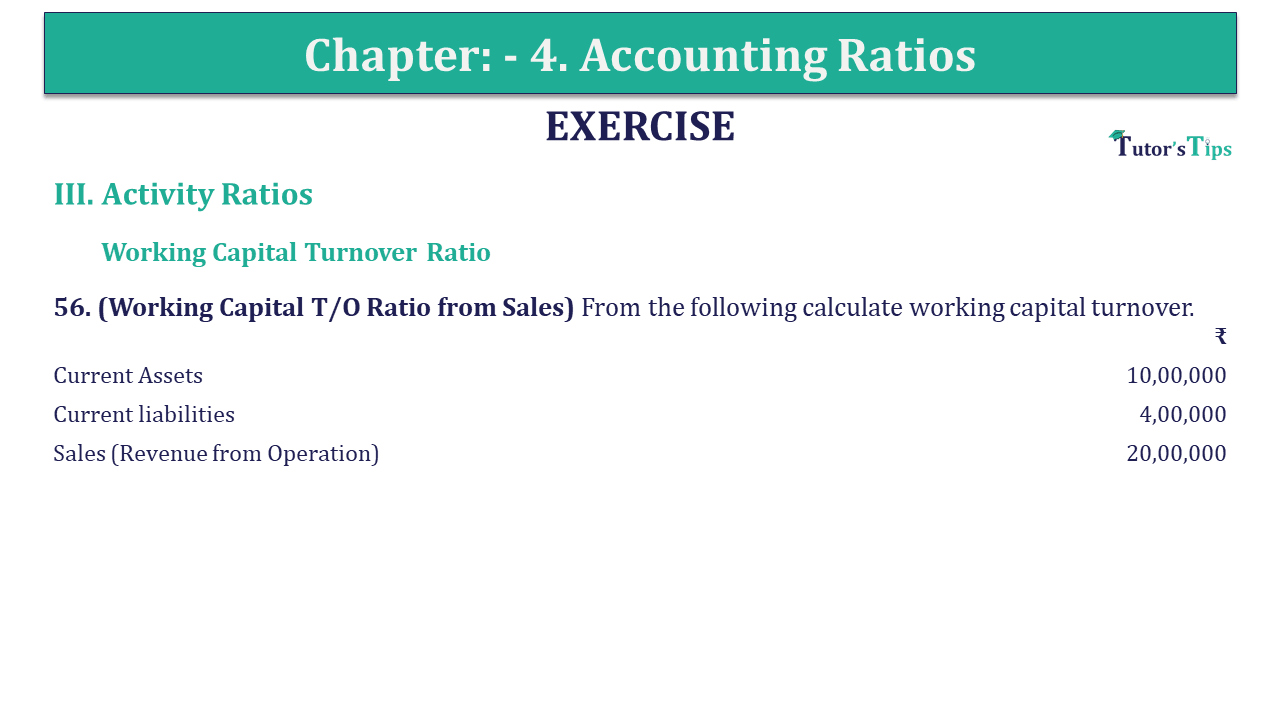Question 106 Chapter 4 of +2-B
Miscellaneous (Analytical Questions)
106. (Stock T/O Ratio/C.A./Stock) From the given information, calculate the stock turnover ratio.
(a) Sales (Revenue from Operations) ₹ 3,00,000, Gross profit 25% on cost. Opening Stock was 1/3rd of the value of the closing stock. The closing stock was 30% of sales.
(b) A business has a current ratio of 3: 1 and a quick ratio of 1.2: 1. If the working capital is ₹ 1,50,000. Calculate the total current Assets and stock.
The solution of Question 106 Chapter 4 of +2-B: –
| (a) Stock Turnover Ratio | = | Cost of Goods Sold |
| Average Stock | ||
| = | ₹ 2,40,000 | |
| ₹ 60,000 | ||
| = | 4 times |
Working Notes :
Calculation of Cost of goods Sold :
| Gross Profit | = | 25% on Costs |
| Sales | = | ₹ 3,00,000 |
| Cost Price | = | ₹ 100 |
| Gross Profit | = | ₹ 25 |
| Sale Price | = | ₹ 125 |
| Gross Profit | = | Price | X | Sales |
| Sale Price | ||||
| = | ₹ 25 | X | ₹ 3,00,000 | |
| ₹ 125 | ||||
| = | ₹ 60,000 | |||
| Cost of goods sold | = | Sales – Gross Profit | ||
| = | ₹ 3,00,000 – ₹ 60,000 | |||
| = | ₹ 2,40,000 | |||
| (b) Working Capital | = | Current Assets – Current Liabilities | ||
| Current Ratio | = | 3 : 1 | ||
| Working Capital | = | 3-1 | ||
| Working Capital | = | 2 | ||
| If Working Capital 2 then Current Assets | = | 3 | ||
| = | 3 | x | ₹ 1,50,000 | |
| 2 | ||||
| = | ₹ 25,000 | |||
| Working Capital | = | Current Assets – Current Liabilities | ||
| ₹ 1,50,000 | = | ₹ 2,25,000 – Current Liabilities | ||
| = | ₹ 2,25,000 – ₹ 1,50,000 | |||
| = | ₹ 75,000 | |||
| Quick Ratio | = | 1.2: 1 | ||
| 1.2 : 1 | = | Quick Assets | ||
| Current Liabilities | ||||
| = | Quick Assets | |||
| ₹ 75,000 | ||||
| Quick Assets | = | ₹ 75,000 x 1.2 | ||
| = | ₹ 90,000 | |||
| Inventory | = | Current Assets – Quick Assets | ||
| = | ₹ 2,25,000 – ₹ 90,000 | |||
| = | ₹ 1,35,000 |
End of Solution
Check Out the Solution of all questions of this chapter:
The solution to all questions of Chapter No. 14 – Accounting Ratios Class 12 Usha Publication – 2024 is shown as follows, click on the image of the question to get the solution.
Question 02 Chapter 4 of +2-B – USHA Publication 12 Class
Advertisement-X
Question 12 Chapter 4 of +2-B – USHA Publication 12 Class
Advertisement-X
Advertisement-Y
Question 22 Chapter 4 of +2-B – USHA Publication 12 Class
Advertisement-X
Advertisement-Y
Question 31 A Chapter 4 of +2-B – USHA Publication 12 Class
Advertisement-X
Question 41 Chapter 4 of +2-B – USHA Publication 12 Class
Advertisement-X
Advertisement-Y
Question 51 Chapter 4 of +2-B – USHA Publication 12 Class
Advertisement-X
Advertisement-Y
Question 61 Chapter 4 of +2-B – USHA Publication 12 Class
Advertisement-X
Question 71 Chapter 4 of +2-B – USHA Publication 12 Class
Advertisement-X
Advertisement-Y
Question 81 Chapter 4 of +2-B – USHA Publication 12 Class
Advertisement-X
Advertisement-Y
Question 91 Chapter 4 of +2-B – USHA Publication 12 Class
Advertisement-X
Question 101 Chapter 4 of +2-B – USHA Publication 12 Class
Advertisement-X
Advertisement-Y
Question 111 Chapter 4 of +2-B – USHA Publication 12 Class
Advertisement-X
Advertisement-Y
Question 121 Chapter 4 of +2-B – USHA Publication 12 Class
Advertisement-X
Thanks for completing the chapter. If you understand the question or we have helped you with your homework, please share our website on your social media. We are delighted to help you out.
Thanks again.
End of Post
Download a PDF of Chapter No. 14 – Accounting Ratios:
If you want to download a PDF of this chapter then you can do it. Check out our PDF file on our Store page.
Chapter-Wise Solution of Usha Publication Accountancy – Part 2 Class 12 – Session 2024-25 as per the PSEB curriculum
Check out Solutions to all questions of the every chapter shown as under. The Solution of Accountancy – Part 2 Class 12 – Session 2024-25 is provided as per the new book published by Usha Publication.
Chapter No. 8 – Company Accounts (Share Capital)
Chapter No. 9 – Company Accounts (Issue of Debentures)
Chapter No. 10 – Company Accounts (Redemption of Debentures)
Chapter No. 11 – Financial Statements of a Company
Advertisement-X
Chapter No. 12 – Financial Statement Analysis
Chapter No. 13 – Tools of Financial Statement Analysis- Comparative and Common Size
Chapter No. 14 – Accounting Ratios
Chapter No. 15 – Cash Flow Statement
Also, Check out our Comprehensive Chapter-wise solution of Advanced Accountancy Part 2 Class 12 by Unimax Publication
- Chapter No. 1 – Company Accounts (Share Capital)
- Chapter No. 2 – Issue of Debentures
- Chapter No. 3 – Redemption of Debentures
- Chapter No. 4 – Financial Statements of a Company (Balance Sheet Only)
- Chapter No. 5 -Financial Statement Analysis
- Chapter No. 6 – Tools/Methods of Financial Analysis
- Chapter No. 7 – Ratio Analysis
- Chapter No. 8 – Cash Flow Statement
Check out Part 1 of both books.
In Class 12th the accountancy has 2 books i.e. Part 1 and Part 2. The Books related to the Part 1 are shown above. but If you want to know more about Part 1, you can check it out from the following links. We have provided the links to both books i.e. Accountancy Part 1 by Usha Publication and Advanced Accountancy Part 2 by Unimax Publication.
1. Accountancy – Part 1 Class 12 – Session 2024-25 By Usha Publication
2. Advanced Accountancy Part 1 Class 12 by Unimax Publication











Leave a Reply